|
|
|
Sort Order |
|
|
|
Items / Page
|
|
|
|
|
|
|
| Srl | Item |
| 1 |
ID:
116929
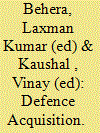

|
|
|
|
|
| Publication |
New Delhi, IDSA, 2013.
|
| Description |
vii,431p.hbk
|
| Standard Number |
9788182747111
|
|
|
|
|
|
|
|
|
|
|
|
Copies: C:2/I:0,R:0,Q:0
Circulation
| Accession# | Call# | Current Location | Status | Policy | Location |
| 057022 | 355.621/BEH 057022 | Main | On Shelf | General | |
| 057023 | 355.621/BEH 057023 | Main | On Shelf | General | |
|
|
|
|
| 2 |
ID:
126691
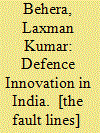

|
|
|
|
|
| Publication |
New Delhi, Institute for Defence Studies and Analyses, 2014.
|
| Description |
60p.Pbk
|
| Series |
IDSA Occasional Paper No. 32
|
| Standard Number |
9789382169314
|
|
|
|
|
|
|
|
|
|
|
|
Copies: C:2/I:0,R:0,Q:0
Circulation
| Accession# | Call# | Current Location | Status | Policy | Location |
| 057567 | 355.00954/BEH 057567 | Main | On Shelf | General | |
| 057568 | 355.00954/BEH 057568 | Main | On Shelf | General | |
|
|
|
|
| 3 |
ID:
138798
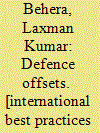

|
|
|
|
|
| Publication |
New Delhi, Institute for Defence Studies and Analyses (IDSA), 2015.
|
| Description |
92p.Pbk
|
| Contents |
IDSA Monograph No.45
|
| Standard Number |
9789382169536
|
|
|
|
|
|
|
|
|
|
|
|
Copies: C:2/I:0,R:0,Q:0
Circulation
| Accession# | Call# | Current Location | Status | Policy | Location |
| 058217 | 355.62120954/BEH 058217 | Main | On Shelf | General | |
| 058218 | 355.62120954/BEH 058218 | Main | On Shelf | General | |
|
|
|
|
| 4 |
ID:
098323
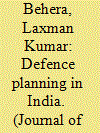

|
|
|
|
|
| Publication |
2010.
|
| Summary/Abstract |
Although India's defence planning mechanism has evolved over the years, it is
still inadequate with respect to prioritisation of precious resources, optimum
force suture and creation of a strong domestic defence industrial base. Given
India's complex security environment and massive expenditure on national
defence, the planning mechanism needs to be strengthened by articulation of
national security objectives and creation of Chief of Defence Staff (CDS). The
CDS and its supporting structure, as argued by the Group of Ministers (GoM),
would be in a better position to bring in necessary reforms which the present
system is constrained to do.
|
|
|
|
|
|
|
|
|
|
|
|
|
|
|
|
| 5 |
ID:
108140
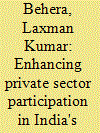

|
|
|
| 6 |
ID:
175884
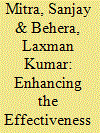

|
|
|
|
|
| Summary/Abstract |
Post-COVID, the renewed emphasis on indigenisation in India calls for a fresh, in-depth examination of the entire range of issues and policies pertaining to the development of a capable domestic base for the defence industry and technology. This study opens up the field of inquiry, first, by adapting the well-known Delphi method for the indigenous development and manufacture of bullet-proof jackets and then in trying to examine all the elements of the decision-making process—from framing requirements by the armed forces to final procurement by the government, through an elaborately structured, multi-stakeholder consultative process. The approach can possibly be tailored to examine more complex systems that require indigenisation.
|
|
|
|
|
|
|
|
|
|
|
|
|
|
|
|
| 7 |
ID:
182630
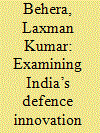

|
|
|
|
|
| Summary/Abstract |
India has expended a great deal of energy and resources to set up a vast defence economy to innovate state-of-the-art weapon systems. However, the performance of the defence economy has been largely suboptimal. An examination of the causes of poor performance exhibits a number of shortcomings related to India’s both ‘hard’ and ‘soft’ innovation capacities. Lack of strong support from higher political leadership, meager research and development (R&D) and procurement budgets, inefficiency of the main R&D and manufacturing players, poor management of human resources and a weak acquisition system, among others, leave India’s defence innovation in a poor state.
|
|
|
|
|
|
|
|
|
|
|
|
|
|
|
|
| 8 |
ID:
181908
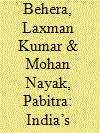

|
|
|
|
|
| Summary/Abstract |
This article examines India’s defence expenditure over the past ten years. In so doing, it provides a public finance perspective to explain the recurring resource crunch being faced by the Ministry of Defence (MoD). The article reasons that a substantial augmentation of resources for the MoD in the past has faced stiff barriers due to lack of tax buoyancy and also the political, economic and other exigencies that have led to greater public spending outside the traditional areas of expenses, including defence. It argues that the MoD needs to re-balance its expenditure, especially in areas pertaining to manpower.
|
|
|
|
|
|
|
|
|
|
|
|
|
|
|
|
| 9 |
ID:
110798
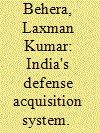

|
|
|
|
|
| Publication |
2012.
|
| Summary/Abstract |
India's defense acquisition system has evolved over the years and now consists of
hierarchical and institutional structures and detailed procedures. The evolved system
has created an atmosphere for undertaking acquisition in a more methodical,
process-oriented and objective manner. The success of the evolved system is evident
from its ability to execute orders worth billions of dollars every year. However,
despite all the success of the evolved system there are certain weak areas that demand
reforms to make the system more accountable and deliver within a prescribed time
frame by optimally utilizing the available resources. Among others, the arms
acquisition needs to flow from a strong planning process that is presently constrained
to bring in the required inter- and intra-service prioritization of weapons acquisition
and ensure holistic development of national capability. The formulation of weapons
systems' requirements-a critical stage of the acquisition cycle, which is presently
carried out within the individual armed forces with inherent weaknesses-needs to
be undertaken preferably by a dedicated and professional body. The accountability
of acquisition also needs to be strengthened by bringing about a centralized, integrated
and professional agency with the responsibility of ensuring timely acquisition.
|
|
|
|
|
|
|
|
|
|
|
|
|
|
|
|
| 10 |
ID:
114617
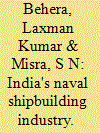

|
|
|
|
|
| Publication |
2012.
|
| Summary/Abstract |
India has created a huge industrial base for naval warship construction. The growing capability of the industry is evident from its ability to construct major warships, including an aircraft carrier, destroyers, frigates and submarines. At the same time, there are certain weaknesses in the industry, which prohibit it from meeting the vast requirement of the maritime forces in the required timeframe and cost efficiently. Among others, the industry as a whole does not operate in a competitive environment, lacks crucial capability in warship design, and lacks civil-military integration for naval construction. Overcoming these challenges will be critical for creating a strong and vibrant naval shipbuilding industry in India.
|
|
|
|
|
|
|
|
|
|
|
|
|
|
|
|
| 11 |
ID:
114916
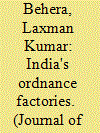

|
|
|
|
|
| Publication |
2012.
|
| Summary/Abstract |
The ordnance factory organization has grown over the years and now consists of 39 factories with two more being set up. The organization, which dates back to the eighteenth century, has however not been able to rise up to the expectation of its prime customer. The paper argues that for the organization to be able function more efficiently, its management needs to be corporatised, as suggested by many, particularly the Kelkar Committee. At the same time, the organization has to assume higher responsibility with respect to R&D investment, execution of contracts, quality assurance and exports, in order to remain competent in its area of functioning.
|
|
|
|
|
|
|
|
|
|
|
|
|
|
|
|
| 12 |
ID:
064765
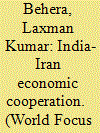

|
|
|
| 13 |
ID:
145164
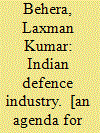

|
|
|
|
|
| Publication |
New Delhi, Pentagon Press (IDSA), 2016.
|
| Description |
xxi, 198p.: table, figureshbk
|
| Standard Number |
9788182749054
|
|
|
|
|
|
|
|
|
|
|
|
Copies: C:2/I:0,R:0,Q:0
Circulation
| Accession# | Call# | Current Location | Status | Policy | Location |
| 058667 | 338.47355054/BEH 058667 | Main | On Shelf | General | |
| 058668 | 338.47355054/BEH 058668 | Main | On Shelf | General | |
|
|
|
|
| 14 |
ID:
122492
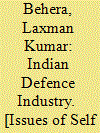

|
|
|
|
|
| Publication |
New Delhi, Institute for Defence Studies & Analyses, 2013.
|
| Description |
150p.Pbk
|
| Series |
IDSA Monograph Series No.21
|
| Standard Number |
9789382169215
|
|
|
|
|
|
|
|
|
|
|
|
Copies: C:2/I:0,R:0,Q:0
Circulation
| Accession# | Call# | Current Location | Status | Policy | Location |
| 057373 | 338.473550954/BEH 057373 | Main | On Shelf | General | |
| 057374 | 338.473550954/BEH 057374 | Main | On Shelf | General | |
|
|
|
|
| 15 |
ID:
077497
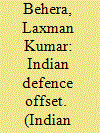

|
|
|
| 16 |
ID:
140960
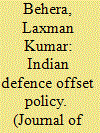

|
|
|
|
|
| Summary/Abstract |
The article assesses the impact of defence offset policy on the Indian defence industry, by taking into account two key parameters—foreign direct investment (FDI) inflows and exports. It observes that the offset policy has a mixed impact. On the positive side, the offset policy seems to have an impact on certain types of exports. On the negative side, the policy has not been a catalyst in bringing in foreign investment and technology inflows into the Indian defence industry, nor has it been successful in promoting its high-end manufacturing. Besides, majority of exports that the policy seems to have promoted is largely confined to parts and components.
|
|
|
|
|
|
|
|
|
|
|
|
|
|
|
|
| 17 |
ID:
098043
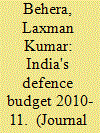

|
|
|
| 18 |
ID:
176931
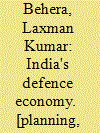

|
|
|
|
|
| Publication |
Oxon, Routledge, 2021.
|
| Description |
xix, 197p.: figures, tableshbk
|
| Standard Number |
9780367750046
|
|
|
|
|
|
|
|
|
|
|
|
Copies: C:2/I:1,R:0,Q:0
Circulation
| Accession# | Call# | Current Location | Status | Policy | Location | IssuedTo | DueOn |
| 059983 | 338.4/BEH 059983 | Main | Issued | General | | RA70 | 19-May-2024 |
| 059984 | 338.4/BEH 059984 | Main | On Shelf | General | | | |
|
|
|
|
| 19 |
ID:
086241
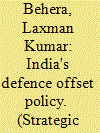

|
|
|
|
|
| Publication |
2009.
|
| Summary/Abstract |
Although India has established a formal mechanism for implementation of the defence offset policy, the structure and procedures lack the thrust to fulfil the objective of energizing the Indian defence industry. Besides, the policy is not supported by the existing Foreign Direct Investment (FDI) and licensing policies. While evidence suggests that domestic industry can absorb offsets, what India needs is an effective body to handle offsets, liberal FDI and licensing policies, and a better banking provision. Also there is a need for a clear roadmap for transfer of technology through offsets, keeping in view India's long-term military industrial objectives.
|
|
|
|
|
|
|
|
|
|
|
|
|
|
|
|
| 20 |
ID:
091260
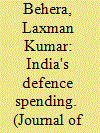

|
|
|
|
|
| Publication |
2009.
|
| Summary/Abstract |
As far as inter-service allocation is concerned, despite fluctuations in the respective shares of the three services in the defence budget, the Army still accounts for the largest share, followed by the Air Force and the Navy. However, in past two decades up to 2008-08, the army has witnessed a decrease in its share in the overall budget, whereas the Navy and Air Force have increased their respective shares.
|
|
|
|
|
|
|
|
|
|
|
|
|
|
|
|
|
|
|
|
|